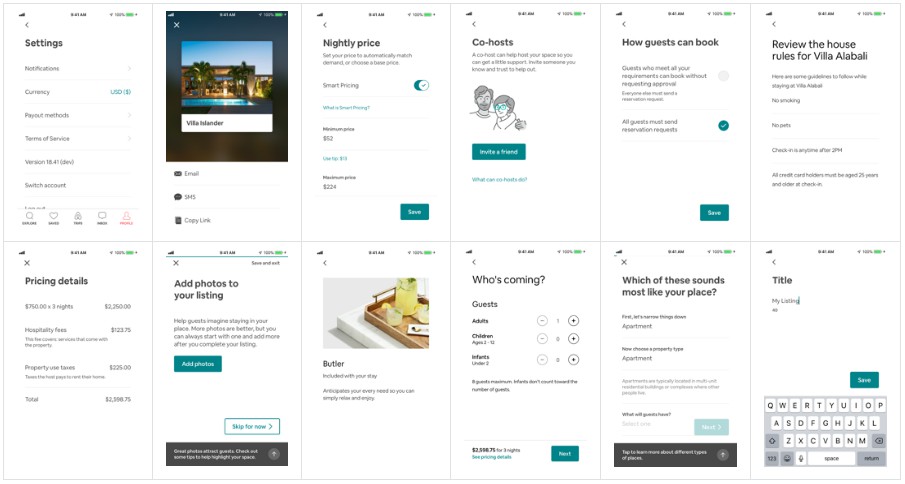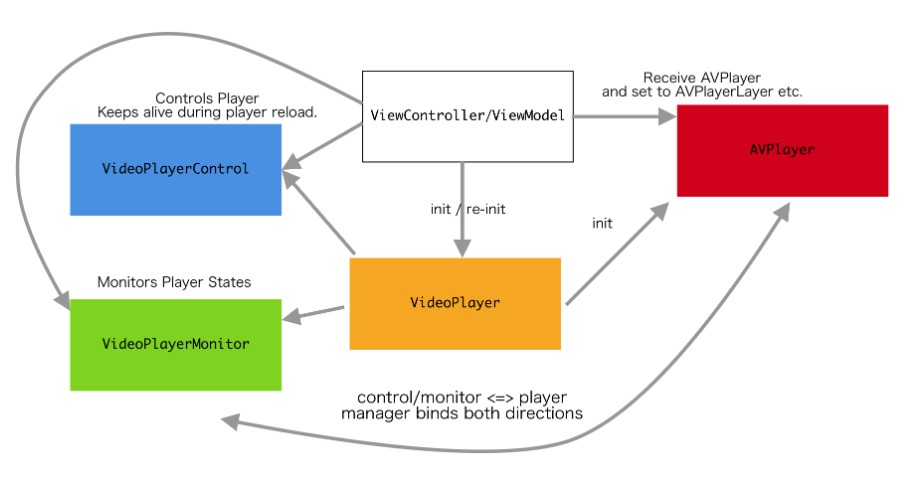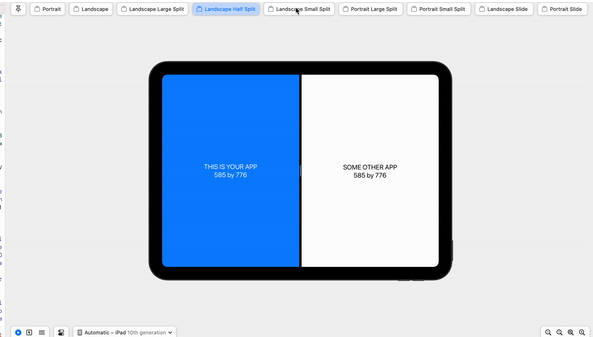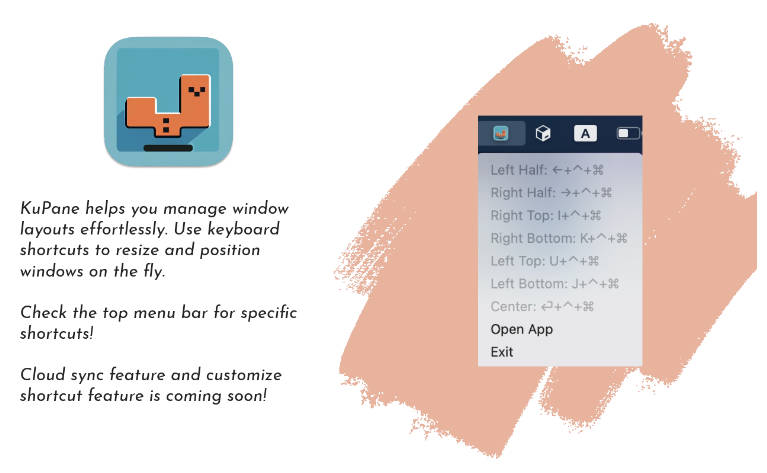AloeStackView
A simple class for laying out a collection of views with a convenient API, while leveraging the power of Auto Layout.
AloeStackView is a class that allows a collection of views to be laid out in a vertical list. In a broad sense, it is similar
to UITableView, however its implementation is quite different and it makes a different set of trade-offs.
We first started using AloeStackView at Airbnb in our iOS app in 2016. We have since used it to implement nearly
200 screens in the app. The use cases are quite varied: everything from settings screens, to forms for creating a new
listing, to the listing share sheet.
 |
 |
 |
 |
 |
 |
|---|---|---|---|---|---|
 |
 |
 |
 |
 |
 |
AloeStackView focuses first and foremost on making UI very quick, simple, and straightforward to implement. It
does this in two ways:
-
It leverages the power of Auto Layout to automatically update the UI when making changes to views.
-
It forgoes some features of
UITableView, such as view recycling, in order to achieve a much simpler and safer API.
We've found AloeStackView to be a useful piece of infrastructure and hope you find it useful too!
Features
-
Allows you to keep strong references to views and dynamically change their properties, while Auto Layout
automatically keeps the UI up-to-date. -
Allows views to be dynamically added, removed, hidden and shown, with optional animation.
-
Includes built-in support for customizable separators between views.
-
Provides an extensible API, allowing specialized features to be added without modifying
AloeStackViewitself. -
Widely used and vetted in a highly-trafficked iOS app.
-
Small, easy-to-understand codebase (under 500 lines of code) with no external dependencies keeps binary size
increase to a minimum and makes code contributions and debugging painless.
System Requirements
- Deployment target iOS 9.0+
- Xcode 10.0+
- Swift 4.0+
Example App
The repository includes a simple example iOS app.
You can try it out by cloning the repo, opening AloeStackViewExample.xcworkspace, and running the app.
The example app shows a few ways AloeStackView can be used to implement a screen in an iOS app.
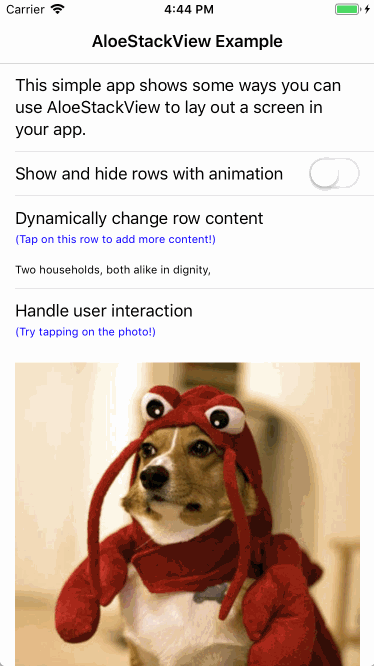
Usage
Creating an AloeStackView
The primary API is accessed via the AloeStackView class.
You can create an instance of AloeStackView quite easily in your code:
import AloeStackView
let stackView = AloeStackView()
AloeStackView is a UIView (specifically a UIScrollView), and thus can be used in the same way as any other
view in your app.
Alternatively, if you want to build an entire UIViewController using AloeStackView, you can use the convenient
AloeStackViewController class:
import AloeStackView
public class MyViewController: AloeStackViewController {
public override func viewDidLoad() {
super.viewDidLoad()
stackView.addRow(...)
}
}
AloeStackViewController is very similar to classes such as UITableViewController and
UICollectionViewController in that it creates and manages an AloeStackView for you. You can access the
AloeStackView via the stackView property. Using AloeStackViewController rather than creating your own
AloeStackView inside a UIViewController simply saves you some typing.
Adding, Removing, and Managing Rows
The API of AloeStackView generally deals with "rows". A row can be any UIView that you want to use in your UI.
Rows are arranged in a vertical column, and each row stretches the full width of the AloeStackView.
To build a UI with AloeStackView, you generally begin by adding the rows that make up your UI:
for i in 1...3 {
let label = UILabel()
label.text = "Label \(i)"
stackView.addRow(label)
}
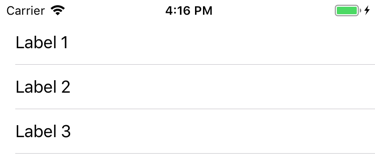
If the length of an AloeStackView ever grows too long for the available screen space, the content automatically
becomes scrollable.
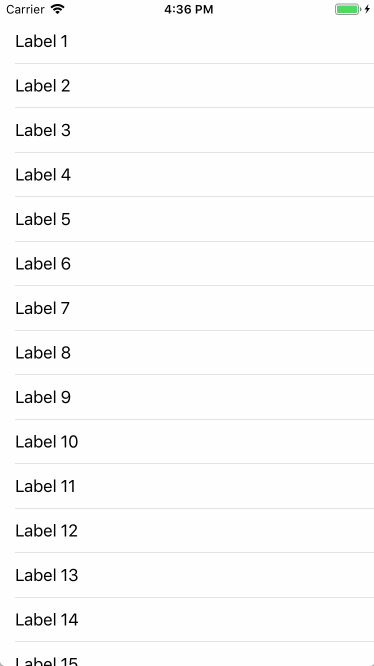
AloeStackView provides a comprehensive set of methods for managing rows, including inserting rows at the
beginning and end, inserting rows above or below other rows, hiding and showing rows, removing rows, and retrieving
rows.
You can customize the spacing around a row with the rowInset property, and the setInset(forRow:) and
setInset(forRows:) methods.
The class documentation in AloeStackView.swift provides full details of
all the APIs available.
Handling User Interaction
AloeStackView provides support for handling tap gestures on a row:
stackView.setTapHandler(
forRow: label,
handler: { [weak self] label in
self?.showAlert(title: "Row Tapped", message: "Tapped on: \(label.text ?? "")")
})
label.isUserInteractionEnabled = true
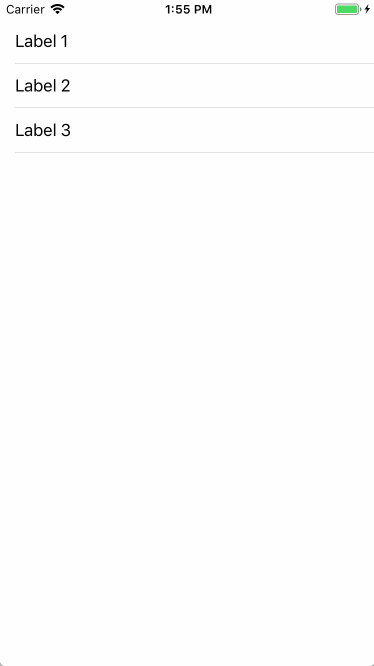
A tap handler will only fire if isUserInteractionEnabled is true for a row.
Another way of handling tap gestures is to conform to the Tappable protocol:
public class ToggleLabel: UILabel, Tappable {
public func didTapView() {
textColor = textColor == .red ? .black : .red
}
}
for i in 1...3 {
let label = ToggleLabel()
label.text = "Label \(i)"
label.isUserInteractionEnabled = true
stackView.addRow(label)
}
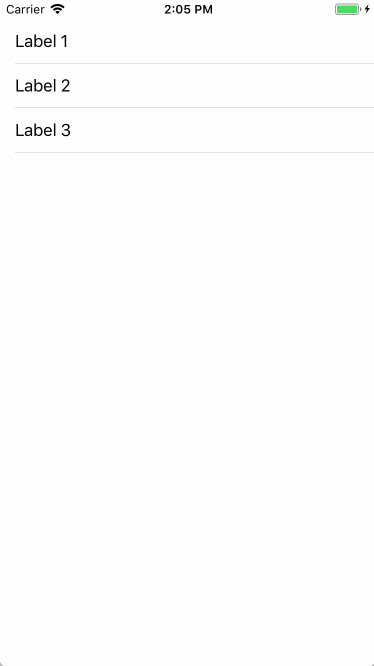
Conforming to Tappable allows common tap gesture handling behavior to be encapsulated inside a view. This way
you can reuse a view in an AloeStackView many times, without writing the same tap gesture handling code each
time.
Dynamically Changing Row Content
One of the advantages of using AloeStackView is that you can keep a strong reference to a view even after you've
added it to an AloeStackView.
If you change a property of a view that affects the layout of the overall UI, AloeStackView will automatically relayout
all of its rows:
stackView.setTapHandler(forRow: label, handler: { label in
label.text = (label.text ?? "") + "\n\nSome more text!"
})

As you can see, there's no need to notify AloeStackView before or after making changes to a view. Auto Layout will
ensure that the UI remains in an up-to-date state.
Styling and Controlling Separators
AloeStackView adds separators between rows by default:

Turning Separators On and Off
You can easily hide separators for any rows that are added to an AloeStackView:
stackView.hidesSeparatorsByDefault = true
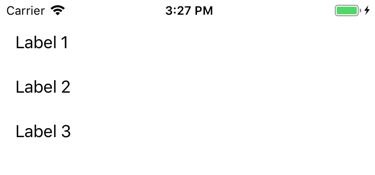
The hidesSeparatorsByDefault property only applies to new rows that are added. Rows already in the
AloeStackView won't be affected.
You can hide or show separators for existing rows with the hideSeparator(forRow:),
hideSeparators(forRows:), showSeparator(forRow:), and showSeparators(forRows:) methods.
AloeStackView also provides a convenient property to automatically hide the last separator:
stackView.automaticallyHidesLastSeparator = true
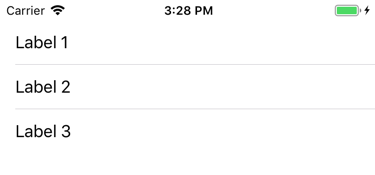
Customizing Separators
You can change the spacing on the left and right of separators:
stackView.separatorInset = .zero
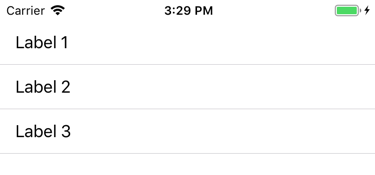
As with hidesSeparatorsByDefault, this property only applies to new rows that are added. Rows already in the
AloeStackView won't be affected.
You can change the separator inset for existing rows with the setSeperatorInset(forRow:) and
setSeperatorInset(forRows:) methods.
AloeStackView also provides properties for customizing the color and height of separators:
stackView.separatorColor = .blue
stackView.separatorHeight = 2
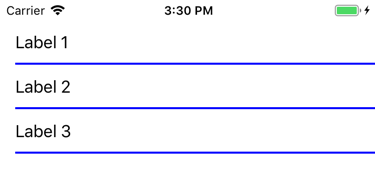
These properties affect all of the separators in the AloeStackView.
Extending AloeStackView
AloeStackView is an open class, so it's easy to subclass to add custom functionality without changing the original
source code. Additionally, AloeStackView provides two methods that can be used to further extend its capabilities.
configureCell(_:)
Every row in an AloeStackView is wrapped in a UIView subclass called StackViewCell. This view is used for
per-row bookkeeping and also manages UI such as separators and insets.
Whenever a row is added or inserted into an AloeStackView, the configureCell(_:) method is called. This
method is passed the newly created StackViewCell for the row.
You can override this method to perform any customization of cells as needed, for example to support custom
features you've added to AloeStackView or control the appearance of rows on the screen.
This method is always called after any default values for the cell have been set, so any changes you make in this
method won't be overwritten by the system.
cellForRow(_:)
Whenever a row is inserted into an AloeStackView, the cellForRow(_:) method is called to obtain a new cell for
the row. By default, cellForRow(_:) simply returns a new StackViewCell that contains the row passed in.
StackViewCell, however, is an open class that can be subclassed to add custom behavior and functionality as
needed. To have AloeStackView use your custom cell, override cellForRow(_:) and return an instance of your
custom subclass.
Providing a custom StackViewCell subclass allows much more find-grained control over how rows are displayed. It
also allows custom data to be stored along with each row, which can be useful to support any functionality you add to
AloeStackView.
One thing to remember is that AloeStackView will apply default values to a cell after it is returned from
cellForRow(_:). Hence, if you need to apply any further customizations to your cell, you should consider doing it in
configureCell(_:).
When to Extend AloeStackView
These methods together provide quite a lot of flexibility for extending AloeStackView to add custom behavior and
functionality.
For example, you can add new methods to AloeStackView to control the way rows are managed, or to support new
types of user interaction. You can customize properties on StackViewCell to control the individual appearance of
each row. You can subclass StackViewCell to store new data and properties with each row in order to support
custom features you add. Subclassing StackViewCell also provides more fine-grained control over how rows are
displayed.
However, this flexibility inevitably comes with a trade-off in terms of complexity and maintenance. AloeStackView
has a comprehensive API that can support a wide variety of use cases out-of-the-box. Hence, it's often better to see if
the behavior you need is available through an existing API before resorting to extending the class to add new features.
This can often save time and effort, both in terms of the cost of developing custom functionality as well as ongoing
maintenance.
When to use AloeStackView
The Short Answer
AloeStackView is best used for shorter screens with less than a screenful or two of content. It is particularly suited to
screens that accept user input, implement forms, or are comprised of a heterogeneous set of views.
However, it's also helpful to dig a bit deeper into the technical details of AloeStackView, as this can help develop a
better understanding of appropriate use cases.
More Details
AloeStackView is a very useful tool to have in the toolbox. Its straightforward, flexible API allows you to build UI
quickly and easily.
Unlike UITableView and UICollectionView, you can keep strong references to views in an AloeStackView and
make changes to them at any point. This will automatically update the entire UI thanks to Auto Layout - there is no
need to notify AloeStackView of the changes.
This makes AloeStackView great for use cases such as forms and screens that take user input. In these situations,
it's often convenient to keep a strong reference to the fields a user is editing, and directly update the UI with validation
feedback.
AloeStackView has no reloadData method, or any way to notify it about changes to your views. This makes it less
error-prone and easier to debug than a class like UITableView. For example, AloeStackView won't crash if not
notified of changes to the underlying data of the views it manages.
Since AloeStackView uses UIStackView under the hood, it doesn't recycle views as you scroll. This eliminates
common bugs caused by not recycling views correctly. You also don't need to independently maintain the state of
views as the user interacts with them, which makes it simpler to implement certain kinds of UI.
However, AloeStackView is not suitable in all situations. AloeStackView lays out the entire UI in a single pass
when your screen loads. As such, longer screens will start seeing a noticeable delay before the UI is displayed for the
first time. This is not a great experience for users and can make an app feel unresponsive to navigation actions.
Hence, AloeStackView should not be used when implementing UI with more than a screenful or two of content.
Forgoing view recycling is also a trade-off: while AloeStackView is faster to write UI with and less error-prone, it will
perform worse and use more memory for longer screens than a class like UITableView. Hence, AloeStackView is
generally not appropriate for screens that contain many views of the same type, all showing similar data. Classes like
UITableView or UICollectionView often perform better in those situations.
While AloeStackView is not the only piece of infrastructure we use to build iOS UI at Airbnb, it has been valuable for
us in many situations. We hope you find it useful too!
Installation
AloeStackView can be installed with Carthage. Simply add
github "airbnb/AloeStackView" to your Cartfile.
AloeStackView can be installed with CocoaPods. Simply add
pod 'AloeStackView' to your Podfile.
